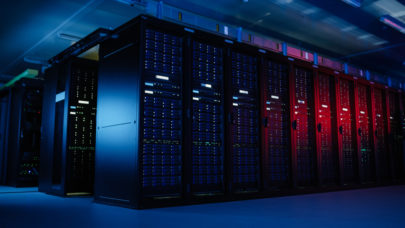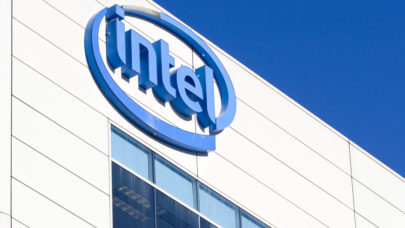
Frontier Supercomputer Powers ‘SCREAM’ Climate Model
April 7, 2023
It’s an exciting time in supercomputing, with functional exascale systems beginning to consistently run crucial workloads. The Frontier supercomputer at Oak R Read more…

Supercomputing Leaders Discuss Resilience in the Face of Growing Crises
December 29, 2022
Many panels at SC22 focused on how supercomputing centers can help others recover from disasters – but one panel, “Facing the Unexpected: Disaster Managemen Read more…

2022 Road Trip: Sandia Brain Trust Sounds Off
November 24, 2022
As the 2022 Great American Supercomputing Road Trip carries on, it’s Sandia’s turn. It was a bright sunny day when I rolled into Albuquerque after a high-sp Read more…

US Pursues Next-gen Exascale Systems with 5-10x the Performance of Frontier
June 28, 2022
With the Linpack exaflops milestone achieved by the Frontier supercomputer at Oak Ridge National Laboratory, the United States is turning its attention to the next crop of exascale machines, some 5-10x more performant than Frontier. At least one such system is being planned for the 2025-2030 timeline, and the DOE is soliciting input from the vendor community... Read more…

Supercomputer Research Uncovers Superhighways on a Supercontinent
May 18, 2021
Supercomputing is used to understand the shapes of otherwise-inscrutable processes, from the atomic-level movements of cells to thousand-year trends in the glob Read more…

Intel Teams with National Labs for Major Leaps in Semiconductors, Neuromorphics
October 2, 2020
After facing setbacks in its semiconductor execution, including a delay in its 7nm node, Intel is announcing two partnerships with U.S. national labs that reaffirm its commitment to advanced computing: first, a partnership with the DOE and the national labs that focuses on developing next-generation semiconductors and manufacturing techniques; and second... Read more…

HPE Strikes Deal to Provide Crossroads, a New Supercomputer for the Nuclear Stockpile
October 1, 2020
The three national laboratories (Lawrence Livermore, Los Alamos and Sandia) that support the National Nuclear Security Administration (NNSA) occupy a strange role in the landscape of government-funded research and supercomputing. The NNSA manages the military applications of nuclear science... Read more…

New Supercomputer Cooling Method Saves Half-Million Gallons of Water at Sandia National Laboratories
February 24, 2020
A new cooling method for supercomputer systems is picking up steam – literally. After saving millions of gallons of water at a National Renewable Energy Laboratory (NREL) datacenter, this innovative approach, called... Read more…

- Click Here for More Headlines

Whitepaper
Transforming Industrial and Automotive Manufacturing
In this era, expansion in digital infrastructure capacity is inevitable. Parallel to this, climate change consciousness is also rising, making sustainability a mandatory part of the organization’s functioning. As computing workloads such as AI and HPC continue to surge, so does the energy consumption, posing environmental woes. IT departments within organizations have a crucial role in combating this challenge. They can significantly drive sustainable practices by influencing newer technologies and process adoption that aid in mitigating the effects of climate change.
While buying more sustainable IT solutions is an option, partnering with IT solutions providers, such and Lenovo and Intel, who are committed to sustainability and aiding customers in executing sustainability strategies is likely to be more impactful.
Learn how Lenovo and Intel, through their partnership, are strongly positioned to address this need with their innovations driving energy efficiency and environmental stewardship.
Download Now
Sponsored by Lenovo
Whitepaper
How Direct Liquid Cooling Improves Data Center Energy Efficiency
Data centers are experiencing increasing power consumption, space constraints and cooling demands due to the unprecedented computing power required by today’s chips and servers. HVAC cooling systems consume approximately 40% of a data center’s electricity. These systems traditionally use air conditioning, air handling and fans to cool the data center facility and IT equipment, ultimately resulting in high energy consumption and high carbon emissions. Data centers are moving to direct liquid cooled (DLC) systems to improve cooling efficiency thus lowering their PUE, operating expenses (OPEX) and carbon footprint.
This paper describes how CoolIT Systems (CoolIT) meets the need for improved energy efficiency in data centers and includes case studies that show how CoolIT’s DLC solutions improve energy efficiency, increase rack density, lower OPEX, and enable sustainability programs. CoolIT is the global market and innovation leader in scalable DLC solutions for the world’s most demanding computing environments. CoolIT’s end-to-end solutions meet the rising demand in cooling and the rising demand for energy efficiency.
Download Now
Sponsored by CoolIT
Advanced Scale Career Development & Workforce Enhancement Center
Featured Advanced Scale Jobs:
HPCwire Resource Library
HPCwire Product Showcase
© 2024 HPCwire. All Rights Reserved. A Tabor Communications Publication
HPCwire is a registered trademark of Tabor Communications, Inc. Use of this site is governed by our Terms of Use and Privacy Policy.
Reproduction in whole or in part in any form or medium without express written permission of Tabor Communications, Inc. is prohibited.
























